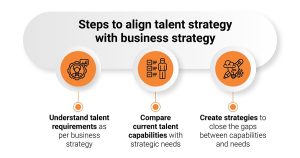Leadership Development Metrics are Driving Success
By Ian Fratarcangeli |
2.8 min read
The term “Soft skills”, once deemed as an unnecessary aspect of the workplace, are now being sought after. Emotional intelligence, which represents many of the social skills we overlook, has a direct correlation to the strength of a leader. Studies have shown that the most effective leaders have a high emotional intelligence, that being four times more reliable than IQ in determining success in their position. Surveys indicate that these leaders perform 40% higher in employee engagement. So how can we discover or even improve the emotional intelligence of our leaders? Using metrics, executives can measure the social skills within an organization to develop those that have the potential to drive the company’s success as leaders.

Align Talent with Business
Leaders have all different responsibilities in the company. A business objective that one leader is tasked with may not be shared with another. This is why its so integral for leaders to be compatible with their business strategy in the development process. Leaders with certain social skills are required to fill certain positions. With metrics, the behaviors of leaders can be determined to find where their skills can be best utilized to achieve success. The top competitors employ metrics to optimize their leadership talent in align with their business aims.

Leadership with Teams
Team performance is vital to the success of the company. Before metrics, managers had a harder time understanding why some teams performed better than others. Now, when developing leaders, there is a clearer comprehension of why teams fail and what has to be done in order to increase performance. On top of that, there is an even clearer metric-driven solution that can be pursued by a leader. An effective leader can use their social skills to connect with the team and create a vision for them that coordinates with each of their behaviors and skills. In every leader’s toolkit should be the optimizing attitude towards the team. The picture can turn from how a team is meeting requirements to how they can optimize their performance with metrics to break new boundaries.
Metrics are the Future
Metrics have shown to be reliable in their implementation in leadership development. Clients of The Predictive Index® have seen improvements in the talent of their leadership, with 81% of them attributing PI to the better development of their employees into leaders. Companies who have optimized the talent of their leaders with PI report 34% higher employee performance and a 16% increase in strategic success, which both contribute to revenue and growth. As more executives realize the importance of metrics in leadership development, more companies benefit from the effectiveness of the optimizing leadership talent with PI. The ability for companies to measure the intangibles of a leader brings about a whole new world of talent optimization.

Predictive Success empowers leaders to optimize workforce performance through proven talent management methodologies, high-performing team building technology, and collected employee or potential candidate data. To learn more about how you can work with our team, please contact us today.
Sources:
Workforce Assessment Tools – The Predictive Index
22 Emotional Intelligence Statistics To Make Your Day (2022) – Soocial
Related Blogs
Benefits of Using Personality Tests for Hiring
Personality Tests Personality tests have been around for decades, used as a way to screen potential candidates during the interview process. So what's changed? In recent years there has been an increase in more corporations
How to Develop Essential Leadership Skills
In recent years the way we work has changed and with that comes a change to leadership. The COVID-19 pandemic made a profound impact on the work environment with an increase in people working from
The Year-End Talent Playbook: Setting Your Workforce Up for Success in 2025
Success in 2025 starts with the decisions you make today. The workforce landscape is rapidly evolving, and organizations must be proactive in aligning their talent strategies with future business goals. The year-end period offers an


